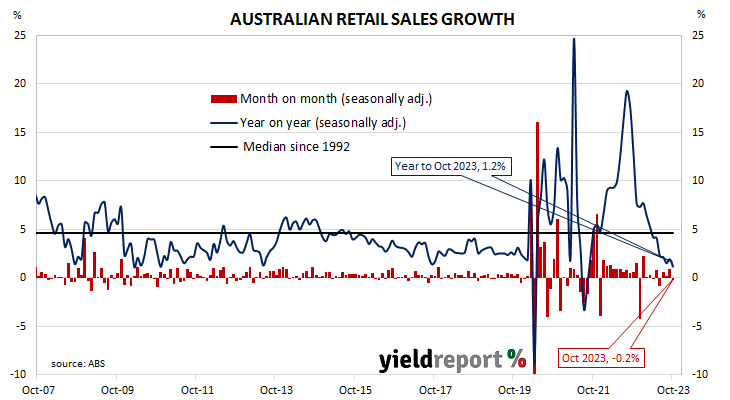Summary: Retail sales down 0.2% in October, contrasts with expected gain; up 1.2% on 12-month basis; ANZ: softest result since August 2021; ACGB yields fall; rate-rise expectations generally soften; Westpac: implies large real, per capita decline in 4.5-5% range; largest influence on result again from food sales.
Growth figures of domestic retail sales spent most of the 2010s at levels below the post-1992 average. While economic conditions had been generally favourable, wage growth and inflation rates were low. Expenditures on goods then jumped in the early stages of 2020 as government restrictions severely altered households’ spending habits. Households mostly reverted to their usual patterns as restrictions eased in the latter part of 2020 and throughout 2021.
According to the latest ABS figures, total retail sales declined by 0.2% on a seasonally adjusted basis in October. The fall contrasted with the 0.2% increase which had been generally expected as well as September’s 0.9% gain. Sales increased by 1.2% on an annual basis, down from September’s comparable figure of 2.0%.
“At 1.2%, annual growth recorded its softest result since August 2021,” said ANZ economist Madeline Dunk. “That is despite elevated inflation and high population growth.”
Long-term Commonwealth Government bond yields moved lower on the day. By the close of business, the 3-year ACGB yield had lost 6bps to 4.17% while 10-year and 20-year yields both finished 7bps lower at 4.51% and 4.77% respectively.
In the cash futures market, expectations regarding further rate rises mostly softened. At the end of the day, contracts implied the cash rate would remain close to the current rate of 4.32% and average 4.34% through December and January but then average 4.425% in February. May 2024 contracts implied a 4.50% average cash rate while August 2024 contracts implied 4.47%, 15bps more than the current rate.
“With population growth running at around 2.4% and retail price inflation running at 3.6% in the September quarter, the result implies a large real, per capita decline in the 4.5-5% range,” said Westpac senior economist Matthew Hassan.
Retail sales are typically segmented into six categories (see below), with the “Food” segment accounting for 40% of total sales. The largest influences on the month’s total again came from this segment where sales rose by 0.5% over the month. However, this was outweighed by lower sales in all of the other categories.



